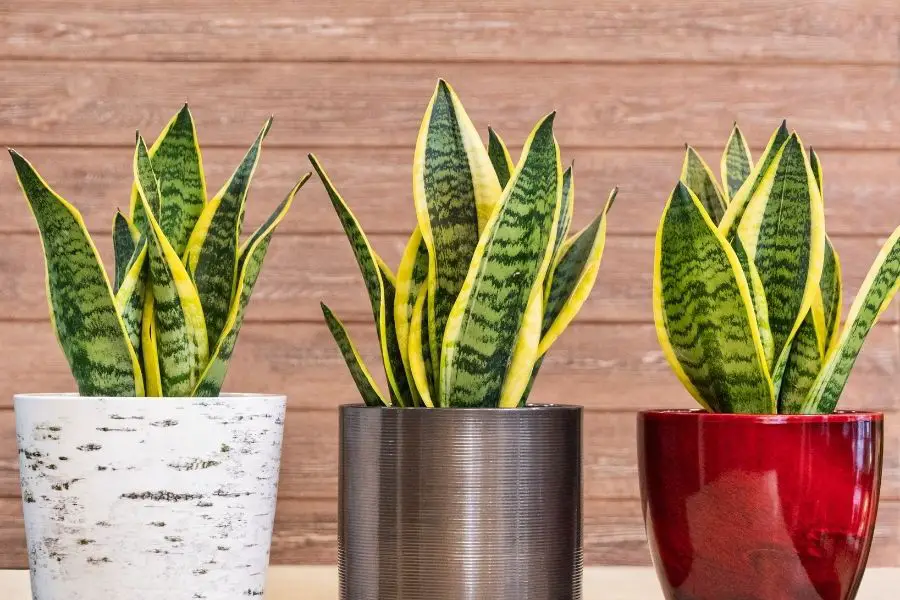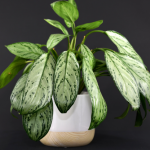
Snake plant (Dracaena trifasciata), also known as mother-in-law’s tongue, is my number one favorite houseplant. It’s the easiest plant I’ve ever had the pleasure of growing and will tolerate even extreme neglect. In this snake plant care guide, I’ll show you how easy it is to grow!
I once went almost six months without watering a forgotten snake plant and it still recovered beautifully! It will forgive any mistake, grows in low light, and needs very little maintenance. It’s the perfect plant for “black thumbs.”
Snake Plant Care
Here’s a brief rundown of basic snake plant care:
- TEMPERATURE: 60 – 75 degrees F (15 – 24 degrees C)
- LIGHT: Bright, indirect (but will tolerate low light)
- HUMIDITY: Low
- WATER: When top 1-inch of soil dries out
- FEEDING: Once a month spring through fall with a succulent fertilizer
- SAFETY: Toxic to humans and pets when ingested, juice from leaves may cause dermatitis
- DIFFICULTY: Easy
Most people don’t realize that this plant is actually a succulent, which contributes to its hardiness. Snake plant is also a great plant for allergy sufferers, as it removes nitrogen oxides and formaldehyde from the air.
The plant’s sturdy, sword-shaped leaves grow upright in dense rosettes and make a bold display anywhere in your home. Although prized for its foliage, a very old snake plant may produce white flowers in the winter.
Water
Water your snake plant only when the top 1 inch (2.5 cm) of soil dries out from spring through fall. I insert my finger up to my first knuckle into the soil and if it feels dry, I’ll water lightly. This usually works out to once every 7 – 10 days.
In the winter, water even less frequently. I water my snake plants once every three to four weeks during winter and that keeps them happy and free of root rot. Snake plant care is easy as long as you don’t over-water.
In the case of snake plant, it’s always better to water too little than too much. If the plant looks healthy, wait a day longer than you normally would to water again. Over-watering is one of the only ways you can kill this hardy houseplant.
Humidity
Since snake plants are succulents, they thrive in dry conditions. They need no supplemental humidity. Do not mist or place too near a humidifier. Wet conditions are not good for this plant.
I grow my snake plant and other cacti/succulents in a separate area of my house away from my tropical plants that need higher humidity.
Fertilizer
Like with all houseplants, fertilizer is an important part of snake plant care. Feed your snake plant once a month in spring through fall with a houseplant fertilizer formulated for succulents.
Although my houseplant fertilizer of choice is typically Jack’s, I use a different brand for my succulents. They need a special blend of nutrients to thrive.
The best I’ve found is Cute Farms Succulent, Cacti, & Aloe Fertilizer (Amazon link). I love how easy it is to apply – just spray on the soil once a month before watering – and it really makes a huge difference in the plant’s growth. I switched to this from Miracle-Gro and never looked back!
Light
Place snake plant in an area that receives bright, indirect light for the best results. It will grow fine in a north-facing window, but growth will be faster in an east- or west-facing window.
Although the plant is well-known for its ability to tolerate low light, it will grow more quickly and look best if grown in bright, filtered sunlight. If you have a low light area of your home that you want to spruce up with a plant, this one will do just fine – it may just grow more slowly.
Never place snake plant in direct sun. If you place your plant in a window that receives direct sun, make sure to move it at least three feet away from the glass.
Temperature
Regular household temperatures are usually enough for your snake plant to thrive, although it prefers a warmer climate.
Keep your indoor temperature from 60 – 75 degrees F (15 – 24 degrees C) for the best results. The plant can tolerate warmer temperatures much better than colder ones. Never let your indoor temperature drop below 60 degrees F (15 degrees C) and you shouldn’t have any problems.
Potting
Plant in a well-draining potting mix formulated for succulents. I like this one by Superfly Bonsai. It’s a bit pricey, but it’s the best formula I’ve found. My snake plants and other succulents thrive in it.
Re-pot your snake plant in spring only when the it’s tightly root-bound. Choose a pot that’s not too big (maybe one size bigger), as snake plant likes its roots crowded.
Terracotta pots work best as they are naturally drying and provide optimal drainage. Whatever pot you choose, make sure it has adequate drainage holes.
Propagation
The best and easiest way to propagate a snake plant is through division. If you have a variegated type, this is the only way to maintain the marginal green stripe. Plants started from cuttings will lose their stripe. Divide plants in spring while re-potting.
If your plant is not variegated and you prefer to take cuttings, cut portions of green, healthy leaves into 3- and 4-inch segments. Dip the lower end into rooting hormone and place in a lightweight potting mix. Keep the soil moist, but not wet. In a few months, you’ll see new shoots coming from the base.
Maintenance
Clean the leaves with a soft sponge or damp cloth occasionally to remove dust. I have a large snake plant that I like to give a warm shower once a month or so to clean the leaves. I place it in the bathtub and use the sprayer nozzle to spray it down.
Besides that, the plant requires no other regular maintenance aside from its general care (watering, feeding, re-potting, etc).
Troubleshooting
Here are some common concerns with snake plant care and what to do about them:
- Soft or Droopy Leaves – If your plant’s leaves become soft and floppy, that’s typically a sign of over-feeding or under-watering. Stop fertilizing for a month or two and make sure you don’t let the soil dry out completely between watering.
- Yellow Leaves – If the leaves of your snake plant are turning yellow and/or flopping over, this can be a sign of root rot, over-watering, or temperatures dropping too low. Make sure you keep the plant in a place that never drops below 59 degrees F (15 degrees C). Reduce watering, and if necessary, pull the plant out of the pot and remove any mushy roots.
- Brown Patches on Leaves – This is usually caused by over-watering (the biggest concern by far with snake plant care). Water less often, but don’t let the soil dry out completely.
- Leaves Losing Color – If your leaves are becoming pale and losing color, this indicates a lack of light. Although tolerant of low light conditions, snake plant still needs some light to survive. Move the plant closer to a window or light source.
Where to Buy Snake Plant
As one of the most popular houseplants in existence, you should have no trouble finding a snake plant at local nurseries and garden centers. If for some reason you can’t get your hands on one (or you want a different variety), I recommend checking on Etsy.
I prefer to buy my houseplants on Etsy because I like supporting small growers. Plus, in my experience they have superior quality and customer service compared to large, corporate nurseries. They care about their reputation and it shows!
Click here to see the current listings for snake plant on Etsy. You can find some great deals there. But my favorite part is the different varieties of plants that may be hard to find at local shops.




